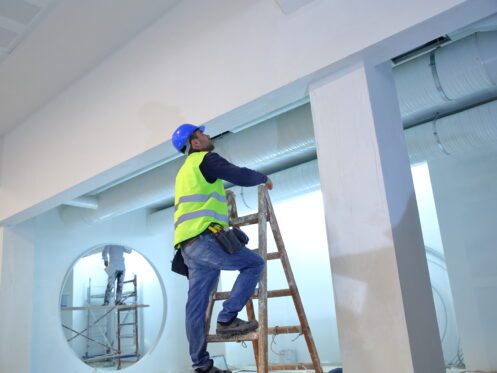Spring in Phoenix means rising temperatures, longer days, and the start of your HVAC system working overtime. Regular repair can help your machine last longer, improve efficiency, and prevent unexpected issues when the heat really kicks in. That’s why it is essential for your business to stay ahead of HVAC problems with a smart spring maintenance plan.
Replace Air Filters for Better Performance
Air filters are a very important part of keeping your HVAC system in good shape. If your filter is dirty or jammed, your system has to work harder, which makes your energy bills go up and puts more stress on the equipment. Over time, this can lead to breakdowns and expensive repairs. Changing your filters regularly helps improve airflow and indoor air quality. If you operate a business with high foot traffic, like a retail store or restaurant, you may need to swap filters more often than the average office space.
When replacing filters, it’s important to choose the right type. Some commercial HVAC systems require specialized filters designed for high-efficiency air purification, while others work fine with standard pleated options. If you’re unsure what’s best for your system, check the manufacturer’s recommendations or consult a professional. A clean filter helps keep dust, allergens, and contaminants out of the air, creating a healthier environment for employees and customers.
Inspect and Clean Outdoor Units
The outdoor unit of your HVAC system is always open to the weather. Spring is the perfect time to check for debris that may have built up around the condenser. Leaves and other debris can clog up your system, making it work harder and even causing it to overheat. If the unit is struggling to pull in air, it won’t be able to cool your space properly.
In commercial settings, outdoor HVAC units are often located on rooftops, in courtyards, or behind buildings. These areas can accumulate dust and grime, especially in dry, windy climates. Clearing out any gunk or blockages can help your system run more smoothly and keep things working like they should. It’s also a good idea to inspect the unit for signs of rust, corrosion, or damage. If coils appear dirty or bent, professional cleaning may be needed to restore proper function.
Test the Thermostat
A thermostat that isn’t working correctly can lead to temperature inconsistencies, discomfort, and higher energy bills. Before the warmest months hit, test your thermostat to make sure it’s reading temperatures accurately and communicating properly with your HVAC system. If your thermostat is old or not working well, switching to a programmable or smart model can make it easier to control the temperature and save energy.
Businesses often have different cooling needs than residential spaces. Office buildings may require zoned cooling for different floors, while restaurants need a system that balances kitchen heat with customer comfort. Take the time to review your current settings and see if any adjustments are needed. If employees are constantly adjusting the thermostat, it might be worth implementing a programmed schedule to keep temperatures consistent throughout the day.
Look Out for Strange Noises or Weird Smells
HVAC systems make some level of noise when running, but loud rattling, banging, or squealing sounds are never a good sign. If you hear anything out of the ordinary, it could indicate a loose component, a worn-out belt, or an issue with the blower motor. These small problems can quickly turn into costly repairs if left unchecked.
Odors are another red flag. A musty smell could mean that mold or mildew is growing in the ducts, while a burning smell could mean that there is a problem with the electrical components or that parts are getting too hot. Any unexpected smells coming from your vents should be addressed as soon as possible. Identifying and fixing problems early helps keep your HVAC system running reliably throughout the season.
Check Ductwork for Leaks or Blockages
Air ducts move cool air through your building, but if there’s a leak, your system has to work extra hard to keep things comfortable, wasting energy and causing uneven cooling. Spring is a great time to check for signs of duct issues, especially if certain areas in your building feel warmer than others.
Leaks can develop at connection points, around joints, or due to cracks in the ductwork. Dust and debris buildup can also reduce efficiency, making it harder for air to flow properly. If airflow is weak in some rooms or temperatures aren’t staying the same, it might be time to have a professional check your ducts. Sealing leaks and clearing out blockages helps maximize system efficiency and ensures that every part of your business stays comfortable.
Check Refrigerant Levels and Look for Leaks
The refrigerant in your HVAC system cools the air inside your building. If refrigerant levels are too low, your system won’t be able to maintain the right temperature, no matter how much it runs. This can make cooling processes last longer, cause energy bills to go up, and put more stress on the fan.
Leaks in refrigerant lines aren’t always obvious. Signs to watch for include warm air coming from the vents, ice forming on the evaporator coils, or a noticeable drop in cooling performance. A professional can test the system, find leaks, and refill it with the right amount of refrigerant. Addressing this early prevents major problems down the line.
Check Electrical Components and Connections
HVAC systems rely on electrical connections to function properly. If wires become loose, frayed, or corroded, they can create safety hazards or cause your system to short-circuit. Spring maintenance should include a check of all electrical components, including circuit breakers, contactors, and wiring.
Loose connections can lead to frequent cycling, inconsistent cooling, or even total system failure. If you’ve noticed lights flickering when your HVAC system turns on, it could be a sign of an electrical issue. A professional inspection can help ensure all components are secure and operating safely.
Schedule a Professional Tune-Up
Even if everything seems to be running fine, scheduling an HVAC tune-up in the spring is one of the best ways to prevent unexpected problems during the hotter months. Technicians can spot hidden issues, clean components that need attention, and make sure your system is running at peak efficiency.
During a professional tune-up, a technician will check refrigerant levels, inspect electrical connections, lubricate moving parts, and assess the system to ensure everything is running smoothly. Taking this proactive step will help your HVAC system last longer and keep your business comfy all year long.
Clean the Drain Lines
Your HVAC system’s condensate drain line helps remove excess moisture produced during the cooling process. If this line gets clogged with algae, or dirt, water can back up into the system, which can cause leaks, water damage, and even mold growth. Spring is the perfect time to check for any blockages and ensure the drain line is clear.
A blocked drain line can lead to unexpected system shutdowns, which is the last thing you need as the weather heats up. If you see water collecting near your indoor unit or notice a musty odor, a clog might be to blame. Having a technician flush the line and check for any damage helps prevent bigger issues later in the season.
Finish Your Spring Checklist Today With Maintenance
You can save time, money, and stress in the months to come by getting ready now. Don’t wait for the first heatwave to realize your system isn’t ready. At Cool Zone Air Conditioning & Heating we specialize in HVAC and indoor air quality services for residential and commercial customers.
Schedule your spring HVAC tune-up with Cool Zone Air Conditioning & Heating today and make sure your establishment in the Phoenix area remains a comfortable place to be.



